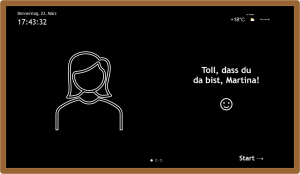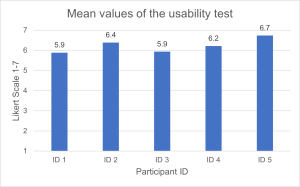The use of smart mirrors in speech therapy in the context of neurological disorders: a needs analysis and exercise development for the smart mirror “mirReha”
Aim and Research Question(s)
Aim of this master thesis was to find out the requirements for smart mirrors, determined by speech therapists working in a neurological environment, and how exercises can be created to meet their needs. Further, a smart mirror prototype was evaluated.
Background
Due to the increasing life expectancy of the population, the number of people developing neurodegenerative diseases and strokes rises [1][2]. These diseases may lead to disorders requiring speech therapy, e.g., Dysarthria or Aphasia. As a result, the emergence of high-frequency and intensive speech therapy increases [3][4]. Extending the therapeutic setting to the home and incorporating technical devices, like smart mirrors, represent a promising way to support this demand [5].
Methods
This descriptive observational study consisted of three phases (Requirements collection phase, Development phase, Evaluation phase). A mixed methods approach was used, including a literature review, a focus group, the development of a new exercise, and further development of existing exercises for the smart mirror prototype "mirReha SpeechTherapy". A usability evaluation of the prototype was conducted through an adapted questionnaire, according to Parreira et al. [6].
 Figure 1: Startpage of "mirReha SpeechTherapy"
Figure 1: Startpage of "mirReha SpeechTherapy"
Results and Discussion
Features perceived as necessary, for a smart mirror to support speech therapy, are intuitive usability due to simple and fast usage, and the personalization of the device, e.g., by adapting the exercises to the users' requirements. The smart mirror prototype was further developed considering the elaborated requirements. A gamified exercise, supporting the training of facial muscles, was developed and existing exercises concerning oral hygiene and neck stretching were enhanced. The evaluation of the questionnaires' closed-ended questions showed a positive outcome. The average mean score was 6.2 of 7 (SD ± 1), which indicates a good usability.
 Figure 2: Mean values of the closed-ended questions
Figure 2: Mean values of the closed-ended questions
Conclusion
The smart mirror prototype “mirReha SpeechTherapy” seems to be useful, easy to use, easy to learn, and satisfying to extend speech therapy. Further work could concentrate on the continued development of the hardware to improve its portability and flexibility, and software, to conduct usability evaluations with neurological patients.
References
[1] Hou et al. (2019), [2] Yousufuddin & Young (2019), [3] Deuschl & Nebel (2017), [4] Doogan et al. (2018), [5] Miotto et al. (2018), [6] Parreira et al. (2020)